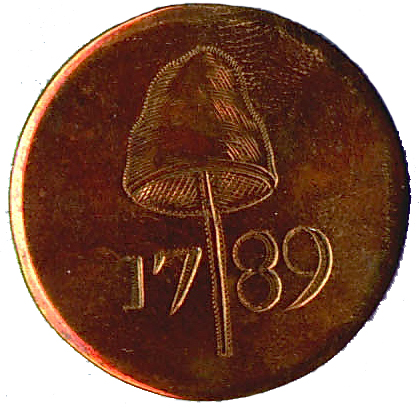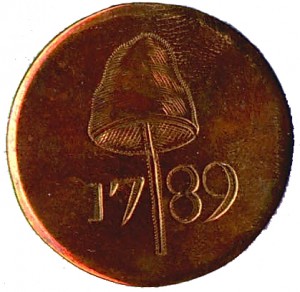This button was most likely fashioned in 1789, by a jeweler for a specific Patriot order during the formation months of a new Continental Congress and Federal Government. Personal Speculation: This could have been for a strong politically active member of the Sons of Liberty or a new Federal Committee Represenative (member) who wanted to be reflective of his personal patriotic struggle during the revolutionary years. The date and insignia combined show a journey and outcome of the European American colonists. The insignia could be seen as the reflection of the people’s desires socially and politically, and the date as a celebratory conclusion of a newly formed federal government along with the state ratification of the United States Constitution. Speculation:
Collectors of GWI buttons could speculate that it is also reflective of George Washington inauguration because of the date, but “I do not see any specific tribute to Washington” taking the button as a whole. (Please no shooting the Roman messenger). People that follow my work know that in 1789 during the year long celebration and tour of Washington, I FIRMLY believe there was two kinds of buttons produced for mass production. GWI’s that are a Tribute to George Washington and honoring him as becoming our first President, and New Nation Tribute Buttons which celebrate the newly formed federal government under a state ratification of a U.S. Constitution.
History:
The Liberty Cap and Pole insignia was used by early revolutionary American Patriots who were members of the Sons of Liberty organizations throughout the colonies as a reflective symbol of independence from the British Parliament and Crown’s introduced taxes and laws. Since, the British colonies in America were made up of a mix of European citizens the Sons of Liberty organizations usually had ethnicity which had close knit memberships of distinct nationalities. This was based on geographical locations within the colonies. Point is that all these European immigrants all had the social and political dream of independence and self- determination away from (Britian) King and religious leaders in other countries setting policies. The introduction of the Liberty Cap and Pole appears to be introduced by Scottish Patriots who were members of the Sons of Liberty in New York and Virginia. Which originated with the House of Stuart earlier against the British for the same dream and religious freedom.
House of Stuart’s Resistance & Restitution
The Phrygian Cap and Liberty Pole was re-introduced propaganda by Prince Edward Stuart in 1745 as a political and social statement agaisnt the House of Hanover. The Jacobite movement was revitalized the Bonnies use again in the 1760’s and reintroduced by an Englishmen-publisher John Wilkes. His printing war and personal association with Benjamin Franklin through England’s social clubs was carried across the Atlantic into the British Colonies in America by the 1770’s.
They Jacobite movement did not completely die out after the Battle of Culloden in 1746, there would be a new generation of sympathizers in Scotland’s Universities, and later social clubs in England. As with any movement they re-purposed earlier propaganda tools to fit their cause along the way. The symbol of the Liberty Cap and Pole took a new face and became a social identity for ones political and social views that were Pro-Bonnie and the Restoration of the House of Stuart. Even though the Hanover’s re-introduced it originally after the 1707 Act, in a persuasive Aristocratic propaganda war against King James II of Scotland, it was turned back (40 years later) upon the Hanover’s by Prince Edward Stuart in 1744-1746. The contextual meaning of this symbol really had the core of the publics Resistance and Restitution from the beheading of Charles I to the return of Charles II.
So, this was re-purposed once again using a Scot context of “Resistance and Restitution” of the House of Stuart. This Scot propaganda War then became transatlantic through Scottish Rite Freemasonry Lodges and would transform the use once again and re-purpose it for the Patriot Cause in the City of New York by Morin Scot. He also happen to be an indirect bloodline to Prince Edward Stuart, and also a founder of the Sons of Liberty in 1760’s. The Liberty Cap & Pole symbolic face became transfigured and re-purposed once again in the British Colonies in America shifting away from Prince Edward Stuart’s personal use against his distant cousins into the British Colonists need of liberty and independence.
************* ************* *************
************* *************

************* ************* *************
Even though the context remained the same of Resistance toward the Hanoverians, it metamorphosed and transfigured into a re-purposed propaganda tool and was used in media warfare and taken into the political realm of state political authoritative objects. In a state official government capacity, the design was used on the paper notes for the state of Georgia, and then was later adopted by the Pennsylvania Council of Safety in 1776. This symbol was used on their official wax seal for various board declarations and ratifications when members would meet. One old theory as to this particular button is that it was probably worn by one of the members on the Committee of Safety in Philadelphia. I would like to add he was part of the Freemason culture movement.

************* ************* *************
GWI 26 THE 1789 LIBERTY CAP ON A POLE : This button was Hand Engraved by Frances Shallus on a plain thin colonial copper planchet. His engraver’s Mark is in the “1”The Size for GWI 26 is 34mm, and has a R-6 Rating. This is a flat one-piece button with a loop shank. The button’s pattern depicts a two-dimensional design of a Liberty Cap on a Pole, with the inaugural year, “1789” below. The year is etched in wide Arabic Style Numbers. For added artistry, the engraver etched small squiggly lines around the outside of the Pole, around the perimeter of the Liberty Cap, and inside of the 1789 Year Date.
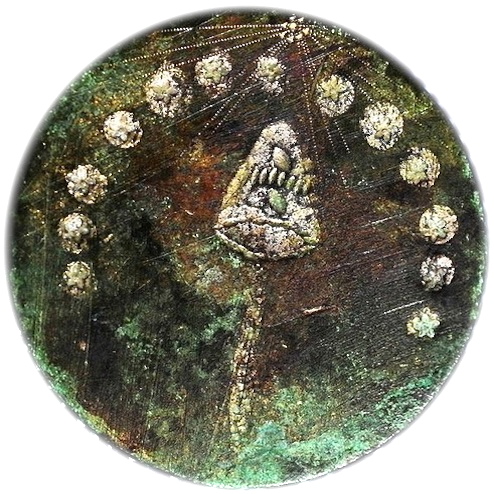 Jacobite Sons of Liberty
Jacobite Sons of Liberty
Royal Tribute Button
Pre-Revolution 1760’s-1770’s
************* ************* *************
************* *************
This is not the only button dug in America to have the Liberty Cap and Pole. As noted in the button pictured above, this is an earlier variation of the Sons of Liberty button depicting the Liberty Cap & Pole. This button distinctly depicts Ancient Scottish Royal Culture motif’s of the Honey Bee and Dog Star. This was most likely worn by a Jacobite within America’s Freemason lodges. This would also show a duel message of hopefulness and a willful orchestration for the Restoration of the House of Stuart and return of Prince Edward Stuart. By the button depicting the Honey Comb and Dog Star it provides a Devine Right of Kings message with a Scottish King Merovingian Bloodline to Jesus Christ.
GWI 26-A THE SONS OF LIBERTY INAUGURAL PATRIOT BUTTON
Color: A Nicely Aged Coppery Brown Color with a Mustard Tone.
Metal: Flat, 1-Piece, Hand Fashioned Design, Copper.
Size: 34mm.
Rarity: R-4
Variety Type: 1789, Wide Numbers.
Present Condition: A Non Dug Specimen, Strong Planchet Condition, An Excellent Impression Remains.
Obverse Button Analysis: This is as close as you can get to mint or museum quality a button can get to. There was only three known owners of this rare button. The copper planchet is solid and flat, and shows no signs of metal fatigue or deterioration. The button has an even copper color throughout the surface, and free of any scratches or harsh abrasions. The Liberty Cap, the Pole, and the Inaugural Year Date all have nice cuts with good detail. The little circular etchings around the the designs are very clear and easily seen. Overall this is a wonderful example that has been preserved nicely.
Reverse Button Analysis: This is a flat one-piece button with a loop shank. The shank is original, straight, and intact. There is no recorded flaws to the surface.
Library Records Has Limited Information GWI 26 A-1:
History: Yes Recorded Sales Price: Yes
Current Button Owner and Location: (Possible Location is the Smithsonian)
Stacks Auctions January 2003.~
Harold Cobb/Descendants 1960 to 2003.~
Cobb Purchased this from F. Cross (Ball) in 1960.~
*This is one of the two known variants of this button. The first is currently held in the United States Mint Collection, which resides in the Smithsonian Institution in Washington D.C. ~ This was found by Helen Richmond in Florida. The second was obtained by Harold Cobb in 1960.
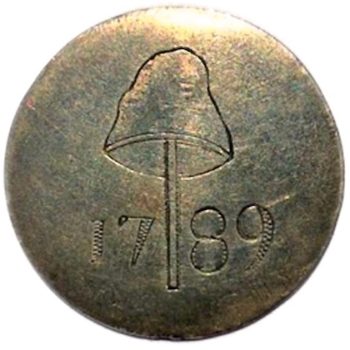
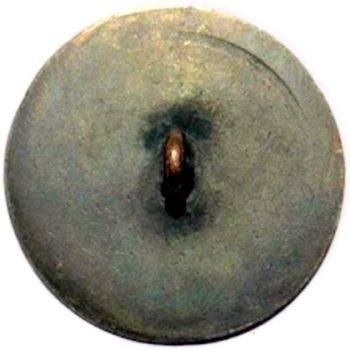
GWI 26-A THE SONS OF LIBERTY SCOTTISH INAUGURAL PATRIOT BUTTON
Color: A Nicely Aged Coppery Brown Color with a Mustard Tone.
Metal: Flat, 1-Piece, Hand Fashioned With Neddles, Copper.
Size: 34mm.
Rarity: R-4
Variety Type: 1789. The Celestial Planets.
Present Condition: A Non Dug Specimen, Strong Planchet Condition, An Excellent Impression Remains.
Obverse Button Analysis: There was only three known owners of this rare button. The copper planchet is solid and flat, and shows no signs of metal fatigue or deterioration. The button has an even copper color throughout the surface, and free of any scratches or harsh abrasions. The Liberty Cap, the Pole, and the Inaugural Year Date all have nice cuts with good detail. The little circular etchings around the the designs are very clear and easily seen. Overall this is a wonderful example that has been preserved nicely.
Reverse Button Analysis: This is a flat one-piece button with a loop shank. The shank is original, straight, and intact.
The Brook Moore Collection.
